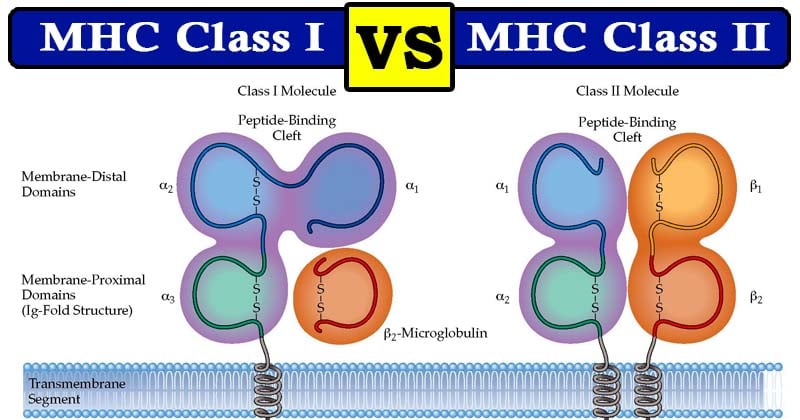Asked Aug 29 2021 in Anatomy Physiology by GradStudent. This molecule is expressed on the surface of.

Mhc Class I Vs Class Ii Definition 15 Differences Examples
View the full answer.

. MHCs are essential for adaptive immunity. While B-cells can bind free antigens in the blood and tissues T-cell receptors can only bind to antigens that are being presented to them by other cells. Class I MHC genes.
They are required to present antigen for the recognition by T cells. They are a set of genes coding for the surface proteins required to identify foreign antigens. Encode glycoproteins expressed on the surface of nearly all nucleated cells.
Which of the following statements describe Class I MHC molecules and which describe Class II MHC molecules. Possess 8-10 amino acids. Class I MHC glycoproteins allow the presentation of foreign epitopes on all nucleated host cells.
This molecule interacts with proteins expressed on the surface of Cytotoxic T cells. To do this MHC class I molecules use whats called the endogenous pathway of antigen presentation. During an infection with Listeria an intracellular bacterium APCs will present antigen on MHC II molecules.
MHC class I molecules consist of one membrane-spanning α chain produced by MHC genes and one β chain produced by the β2-microglobulin gene. This molecule interacts with proteins expressed on the surface of Cytotoxic TClass II MHC cells. This means that a T-cell cannot recognize a bacterium or virus floating.
Class II MHC CBoth Class I and Class II MHC. MHC class II molecules offer exogenous peptides to CD4 T-lymphocyte receptors to commence the normal adaptive. When a cellular protein is marked for degradation its sent to the an organelle called the proteasome - which is found in all nucleated cells.
A MHC class I is a dimer consisting of two chains. This molecule is expressed on the surface of Antigen presenting cells. It is a collection of genes within a long stretch of DNA on chromosome 6 which codes for 3 classes of molecules.
Major Histocompatibility Complex is also known as MHC. Choose the phrase that describes MHC class I molecules Expressed on all human nucleated cells Evaluate the statements below and select those that correctly assess the relationship between MHC molecules and cell surface receptors. This molecule is expressed on all nucleated cells.
MHC class I molecules allow immune cells to sample proteins from within your cells. One alpha chain three subunits and b2 microglobulin chain expressed outside the cell membrane. β-chain is called as β2-microglobulin.
You need to isolate some cells from her collected tissues that express the Class I proteins. MHCI heavy chain molecules associate with beta 2 -microglobulin prior to recruitment into the peptide-loading complex in the endoplasmic reticulum ER. MHC Class I The protein is a cell surface protein and a heterodimer consisting of a long α chain α-subunit and a short β chain β subunit joined by non-covalent interactions.
Both Class I and Class Il MHC. This molecule is expressed on the surface of Antigen. Possess 13-18 amino acids.
Both molecules are synthesized in the rough endoplasmic reticulum and MHC I and MHC II are encoded. Major histocompatibility complex MHC class I antigen processing pathway. Major histocompatibility complex or Human Leukocyte Antigen HLAcomplex consists of genes encoding cell surface glycoproteins that are required for antigen presentation to T cells and also responsible for rapid graft rejectionThe acceptance or rejection of transplant is controlled by a set of genes in the recipients body which is called as.
A Class I MHC. In humans the HLA Human leukocyte antigen complex works similar to MHC. Last updated on November 19 2018 at 1716.
Gennery in Reference Module in Biomedical Sciences 2021 MHC class II deficiency. C Both of the above. Viral epitopes within an infected liver cell are presented by MHC I molecules and bind to cytotoxic T cell receptors.
Recognition molecules MHC molecules. MHC class II molecules are transmembrane glycoprotein heterodimers constructed from α and β chains the genes for which are on the short arm of chromosome 6. A the MHC proteins are made from several different gene regions that are capable of rearranging in a number of ways B MHC proteins from one individual can only be of class I or class II C each of the MHC genes has a large number of alleles but each individual only inherits two for.
This molecule is expressed on all nucleated cells. The major function of the class I gene product is presentation of peptide antigens to TC cells. Youre working in a clinical lab and your boss has asked you to run a test on a patients MHC Class I molecules.
MHC class I molecules are present on the cell surfaces of all nucleated cells and MHC Class II molecules present in antigen presenting cells APC which includes B cells macrophages and dendritic cells. An alpha and a beta-chain each consisting of two subunits expressed outside the cell membrane. This molecule is expressed on all nucleated cells.
Through the T cell receptor. MHC II proteins are located in the membranes of all cells in the body except for mature RBCs macrophages b-cells and dendritic cells. B MHC class I is a dimer consisting of two chains.
MHC class II molecules consist of two membrane-spanning chains α and β both produced by MHC genes. MHC II molecules present. Which of the following statements describe Class I MHC molecules and which describe Class II MHC molecules.
Dendritic cells possess both MHC I and MHC II glycoproteins that bind to cytotoxic and helper T cell receptors respectively. Page created on March 6 2018. Difference between mhc class 1 and 2.

Proximal Promoters Of Mhc Class I And Mhc Class Ii Genes The Promoters Download Scientific Diagram

Basic Process Of Mhc Class I Antigen Presentation Degradation Of Download Scientific Diagram

Antigen Processing And Cross Presentation Via Mhc Class I Molecules Download Scientific Diagram
0 Comments